Accreditation Survey Shines Light on Motives, Benefits
Mary K. Batcher, Quantitative Economics and Statistics
The American Statistical Association has offered accreditation to its members since fall of 2010. Although accreditation has been positively received by many members who have long argued for such a program, there have not been as many applications for accreditation as expected based on earlier expressions of interest. To learn more about why accredited members applied and why some who initially expressed interest did not apply, the ASA Accreditation Committee conducted a survey of all accredited members and a sample of non-accredited members in 2012.
At the time of the survey, there were 163 accredited members, all of whom were surveyed. In addition, 1,581 non-accredited members were surveyed. The non-accredited members surveyed included all who had expressed interest in seeking accreditation but had not applied, all members previously surveyed by the Kettenring Committee, and a random selection of other members. The response rate among accredited members was 65.6%, but was only 17.6% among non-accredited members.
The Kettenring Committee reviewed the proposed accreditation program for the ASA Board. They conducted a survey of 1,000 ASA members; 41% of the respondents to that survey indicated they would seek accreditation if offered.
Results for Non-Accredited Members
Non-accredited members were asked, “What obstacles have prevented you from applying?” They chose from a list of potential difficulties, costs, and information gaps and were instructed to check all that applied. If the response “other” was chosen, they were given the opportunity to provide a short narrative explanation. The results are displayed in Figure 1.
The most frequently selected reasons are about the time needed to collect the necessary information to complete the application and needing more information about the benefits and process.
Although the list of information needed appears formidable, an August 2013 Amstat News article by ASA Executive Director Ron Wasserstein, “ASA Accreditation: Everything You’ve Wanted to Know,” addressed many of the information gaps and perceived obstacles. Wasserstein also included his telephone number and email address for anyone wishing for additional information or guidance.
Non-accredited members were then asked, “What benefits would make accreditation more attractive to you?” They were instructed to check all that applied from a list of potential benefits. If the response “other” was chosen, they were given the opportunity to provide a short narrative explanation. Their responses are displayed in Figure 2.
Choices overwhelmingly favored recognition by employers and awarders of grants or contracts. Other choices were desirable, but more as “nice to have” benefits. The public recognition of accreditation as a valuable credential is difficult for the ASA to influence. Employers frequently cannot distinguish statisticians from other professionals, like economists. Accreditation can help make that distinction; however, until accreditation becomes widespread among those seeking non-academic employment or competing for grants or contracts where statistical knowledge and experience are needed, employers are not likely to include accreditation as a hiring criterion. Over time, as accreditation increases among statisticians, we should see increasing recognition of its value.
When asked whether they planned to pursue accreditation in the future, the majority of the non-accredited members who responded said no, 55.4%, although a substantial minority were either not sure or said they were going to do so, 44.6%. Those who responded no were asked their reasons for not pursuing accreditation; they were again asked to choose all that applied. Their responses are displayed in Figure 3.
The reasons given for not pursuing accreditation make sense. If it is not needed in the member’s current position and existing credentials are sufficient, there is little benefit to the individual to become accredited. ASA accreditation is voluntary; it is not a requirement for participation in the statistical profession. As Sally Morton, a former ASA president, said in the announcement of the ASA accreditation program, “ASA accreditation is for those who feel it will help them professionally. As is demonstrated by similar programs offered by statistical societies in other countries, not everyone will need or want to be accredited.”
Accreditation is not for everyone. However, it is a valuable credential for a subset of the members.
Results for Accredited Members
When asked whether they had or would recommend pursuit of accreditation to friends and colleagues, 93.5% of accredited members said yes. This level of satisfaction is evidence of the value of accreditation to a small but growing subset of ASA members.
Accredited members were asked why they decided to pursue accreditation. Their responses are displayed in Figure 4.
The most frequently chosen responses were accreditation will help distinguish accredited members from their competition and that another credential is a plus, suggesting that, even though there may not be an explicit demand by employers and those awarding contracts or grants, there is some level of perceived competitive advantage for accredited members.
Accredited members receive tangible benefits provided by the ASA. Survey respondents were asked to choose the three most useful benefits provided. Their responses are displayed in Figure 5.
The top three choices are the discounts on continuing education courses at JSM, free LearnStat on Demand, and discounted registration at the Conference on Statistical Practice (CSP), followed by short course discounts at CSP.
The intangible benefits of accreditation were not addressed in this survey; however, one important intangible benefit is support for the profession of statistics. The work of the accredited professional statistician has been peer reviewed. He or she has agreed to adhere to a code of ethics and is keeping current in their statistical areas of expertise by taking short courses, attending the Joint Statistical Meetings and/or CSP, reading relevant articles and texts, submitting journal articles, or participating as journal editors and reviewers. These requirements of accredited members encourage the public to view statistics as a profession, not just a limited set of skills anyone who has taken a class in statistics or has access to the right software can use.

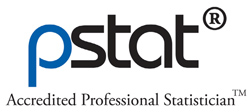
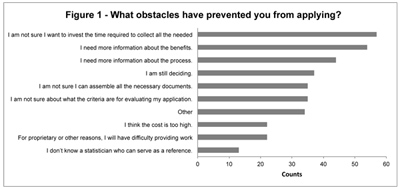
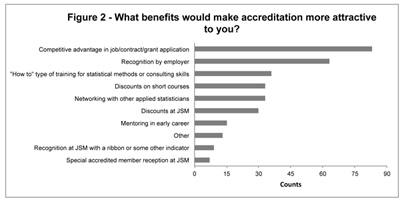
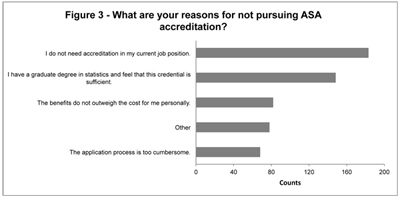
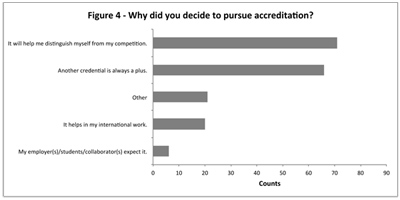
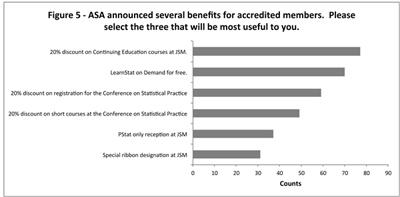

















I considered applying and also shared with colleagues on my Statistical Team, and the primary reason I and at least one other member of my Team did not apply was that the financial cost was too high. I think this may be a major impediment, at least it was for me.